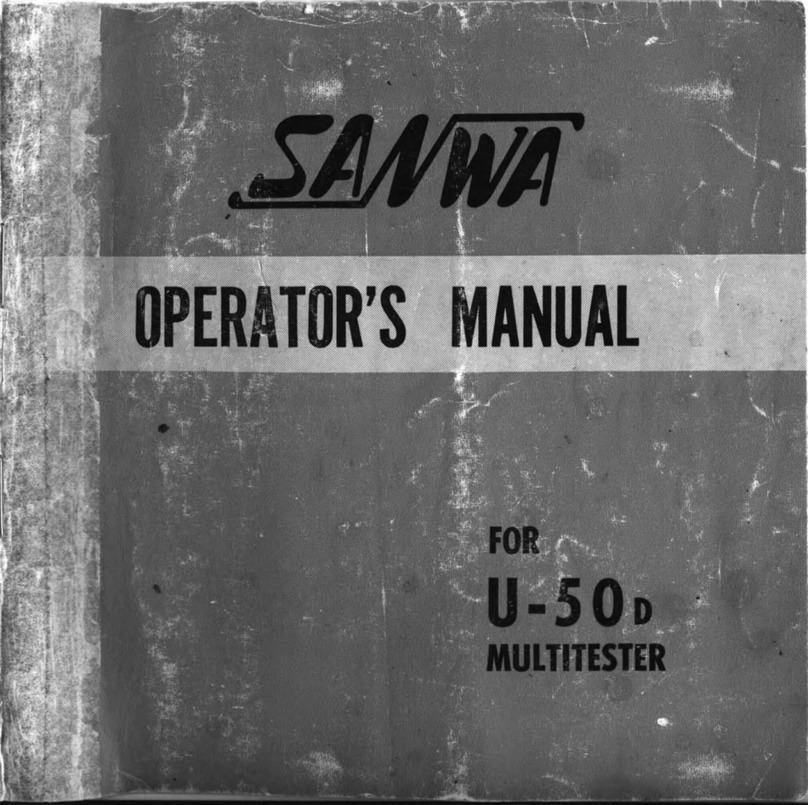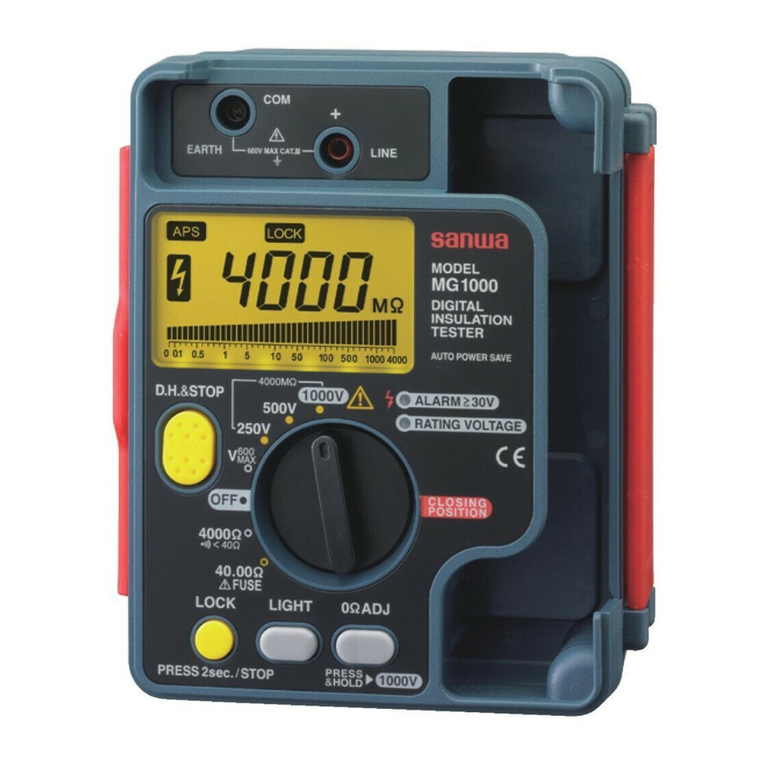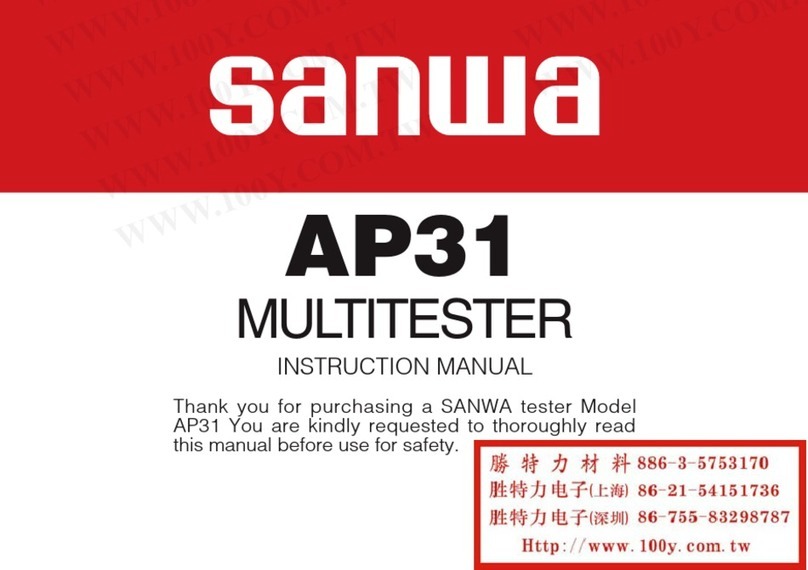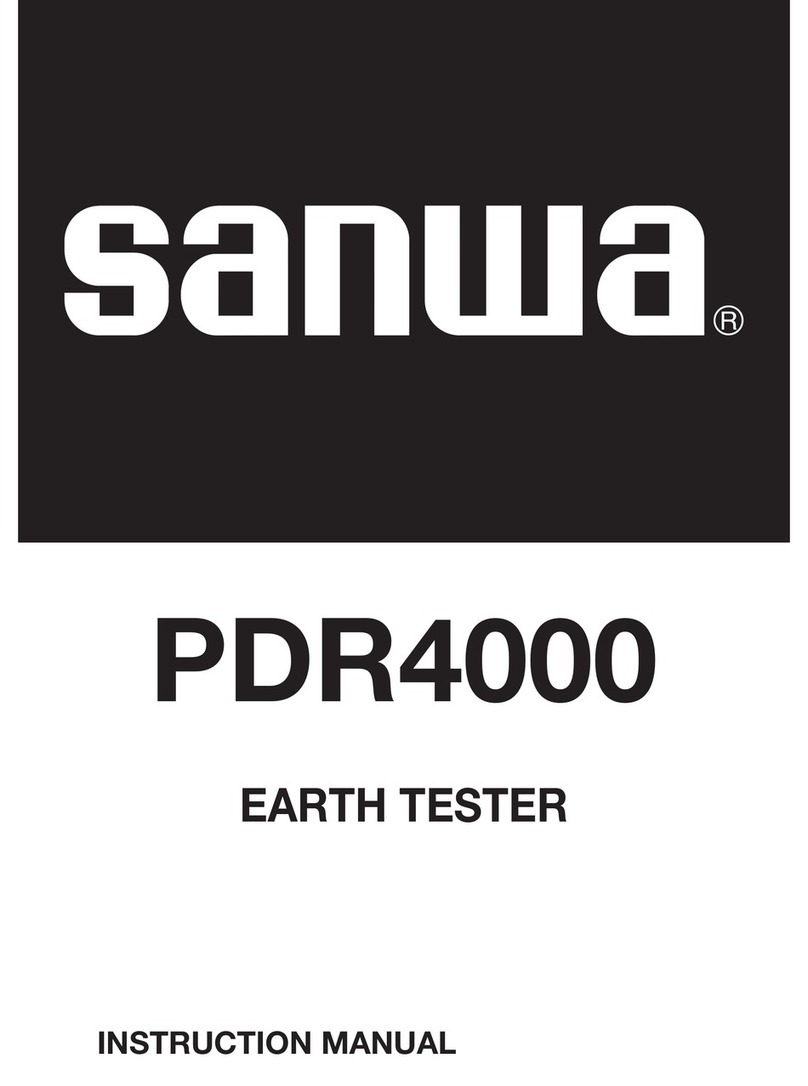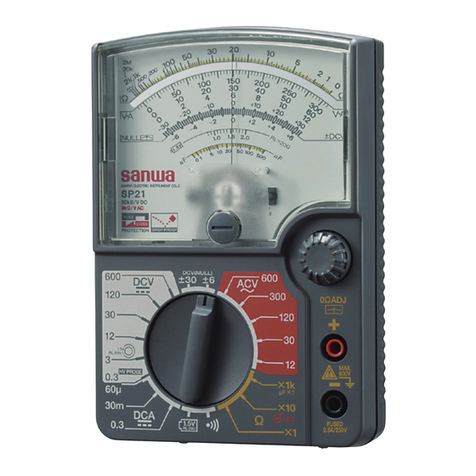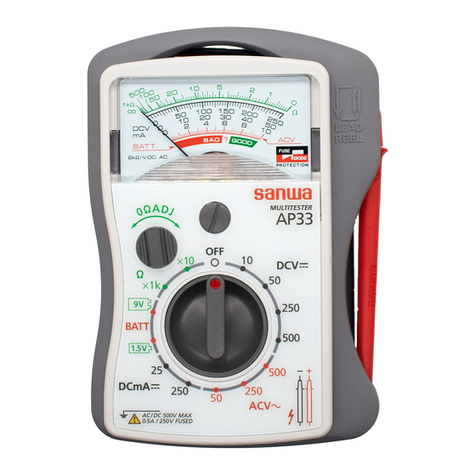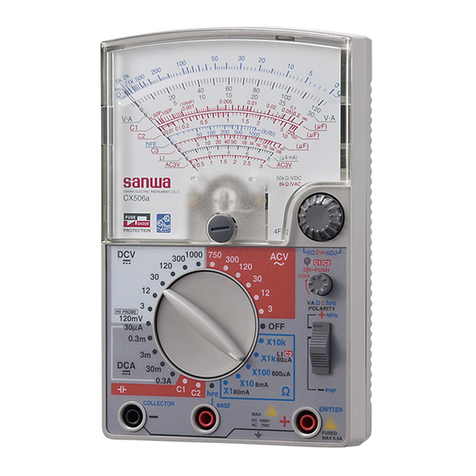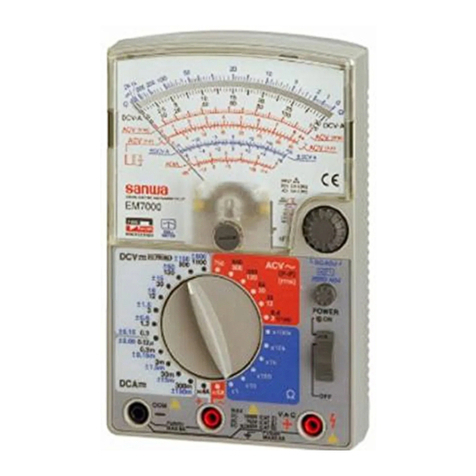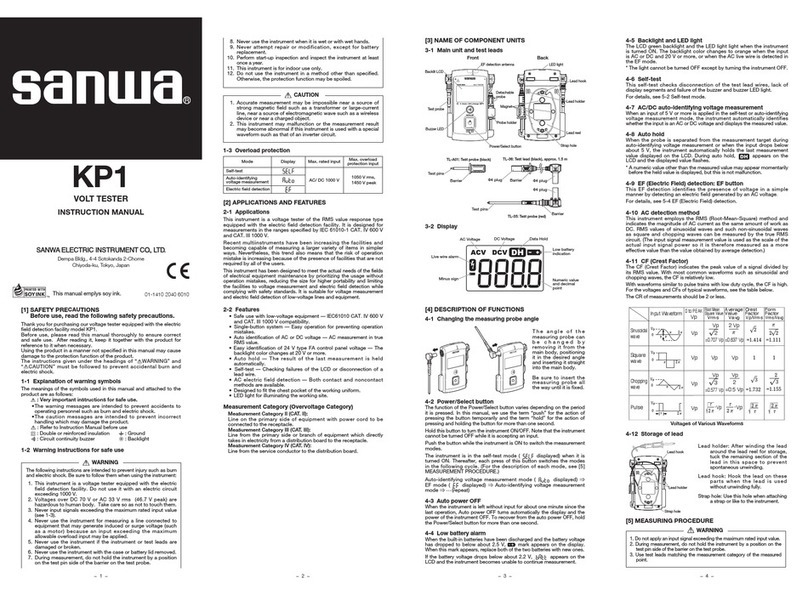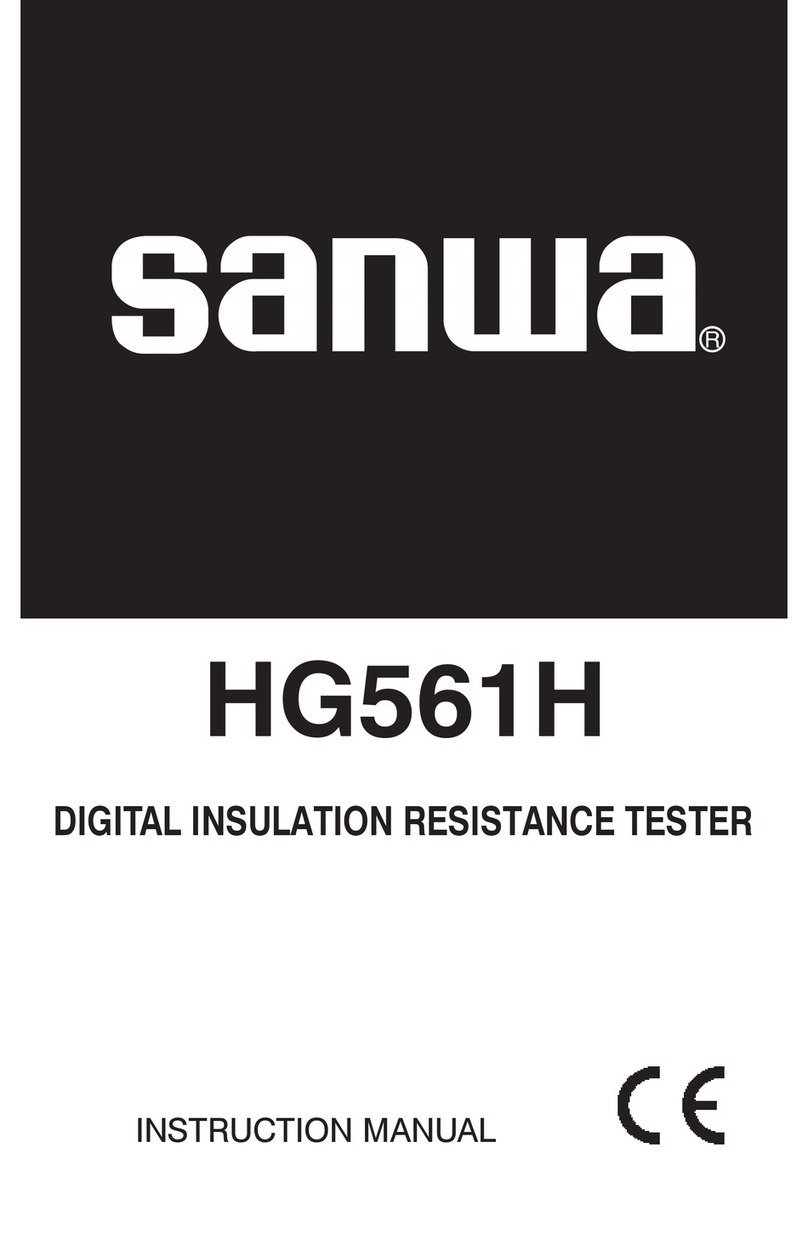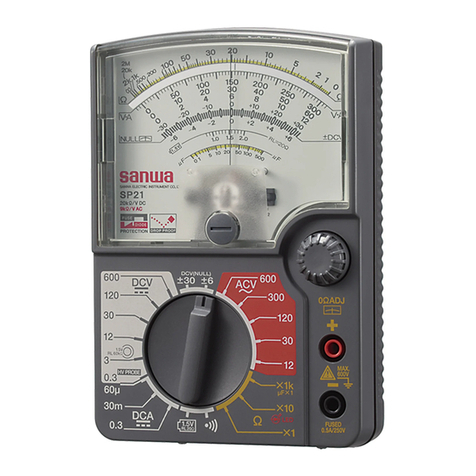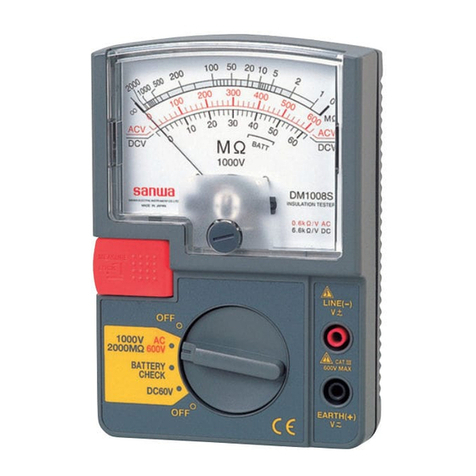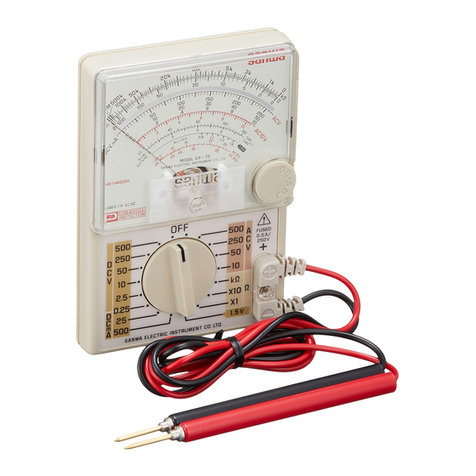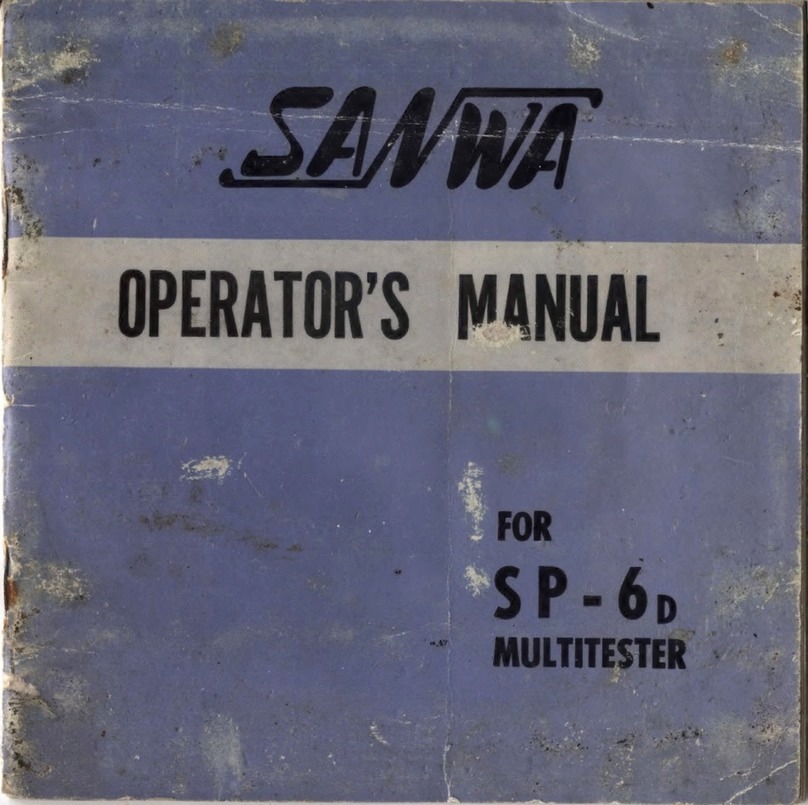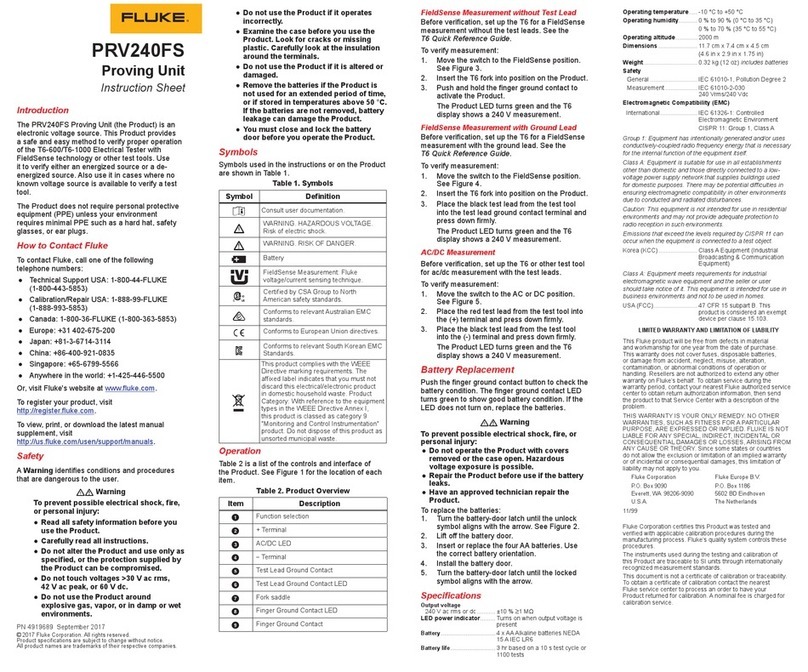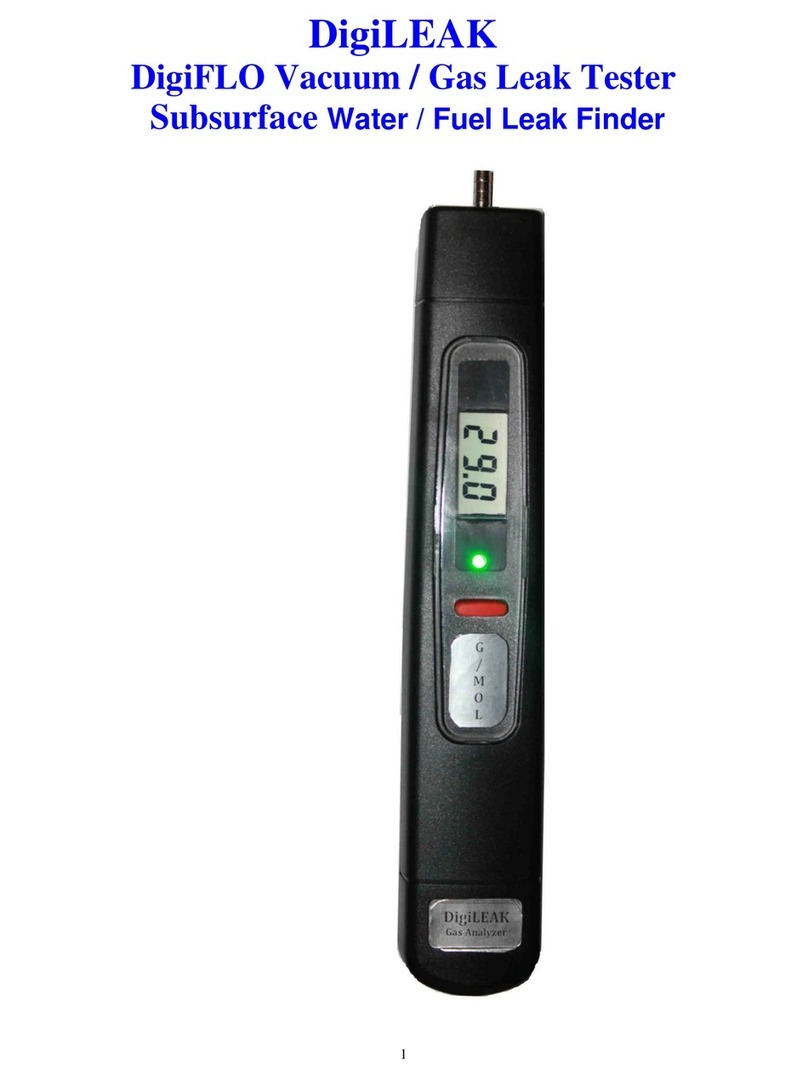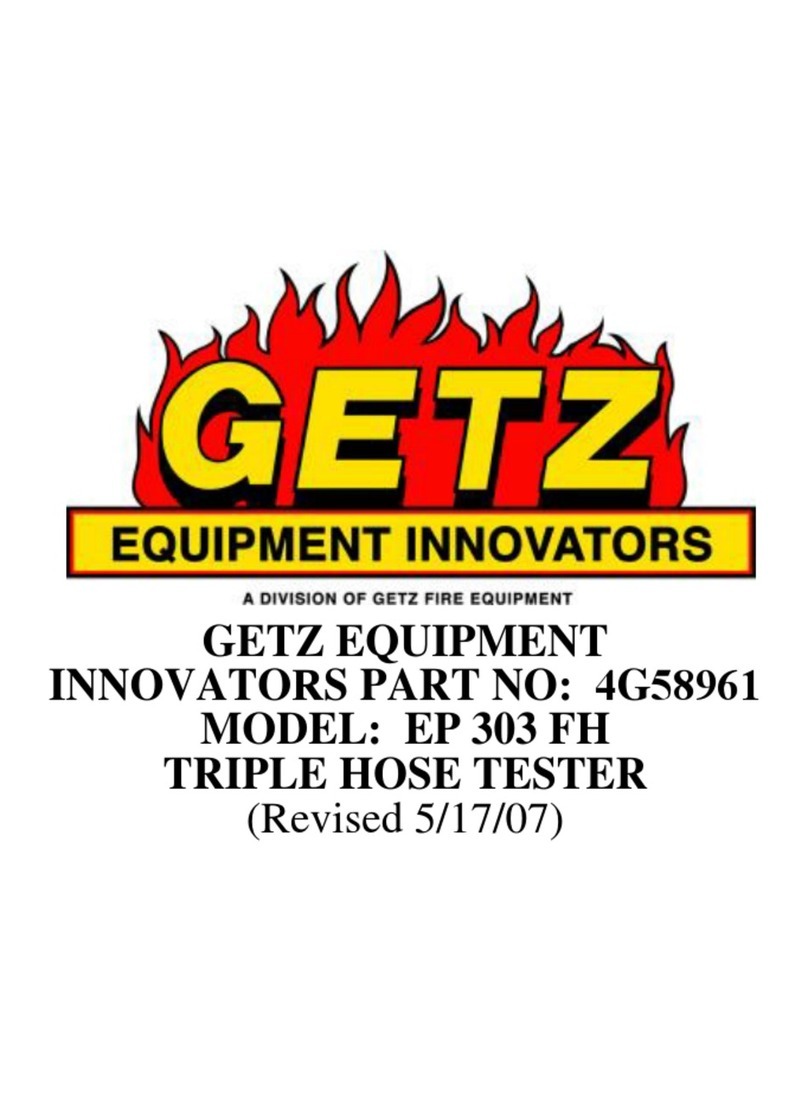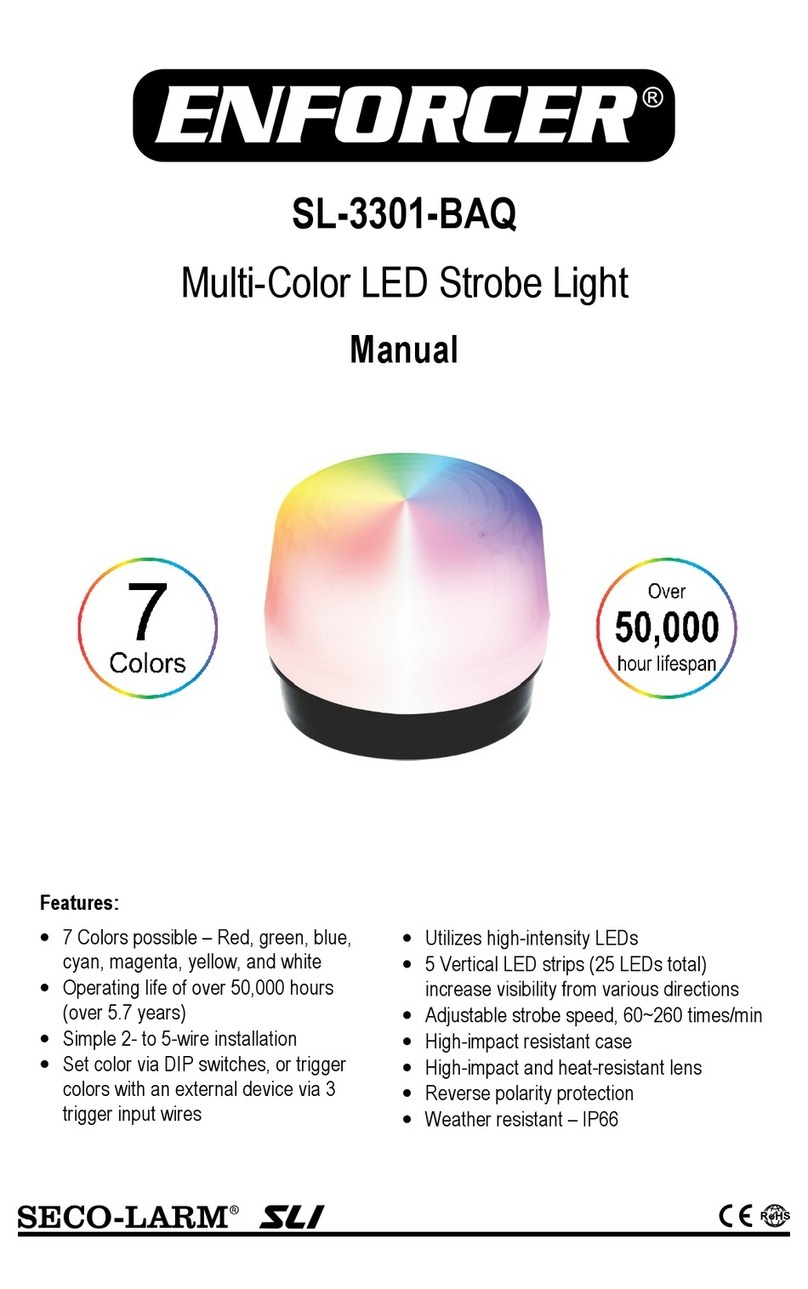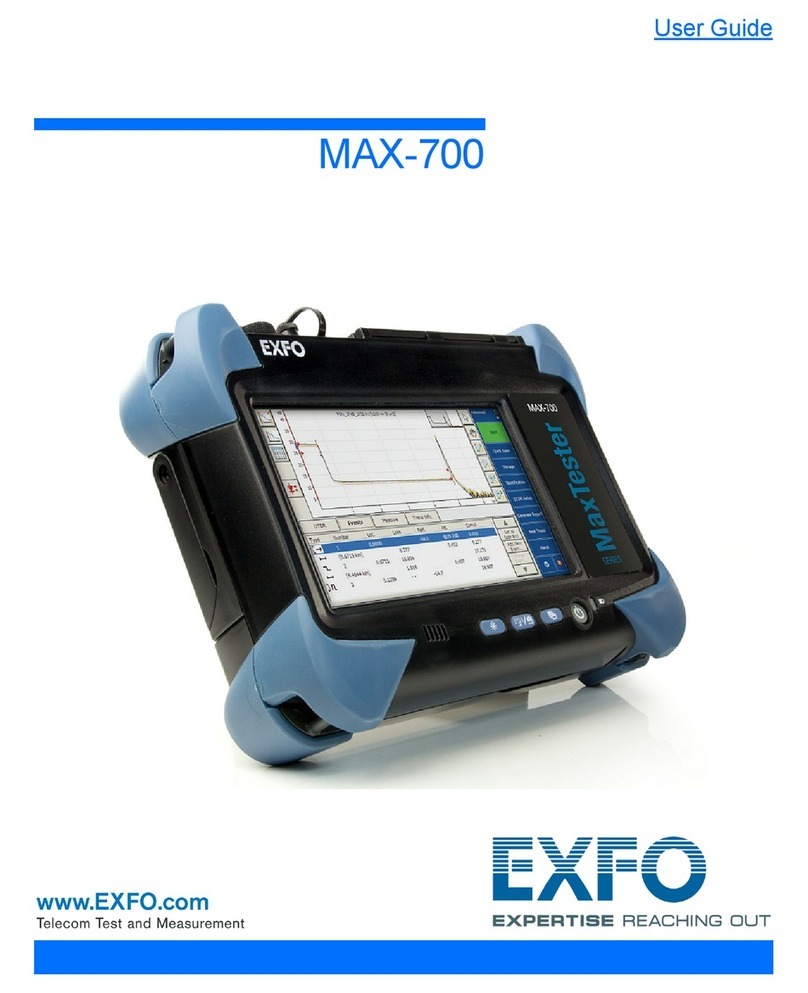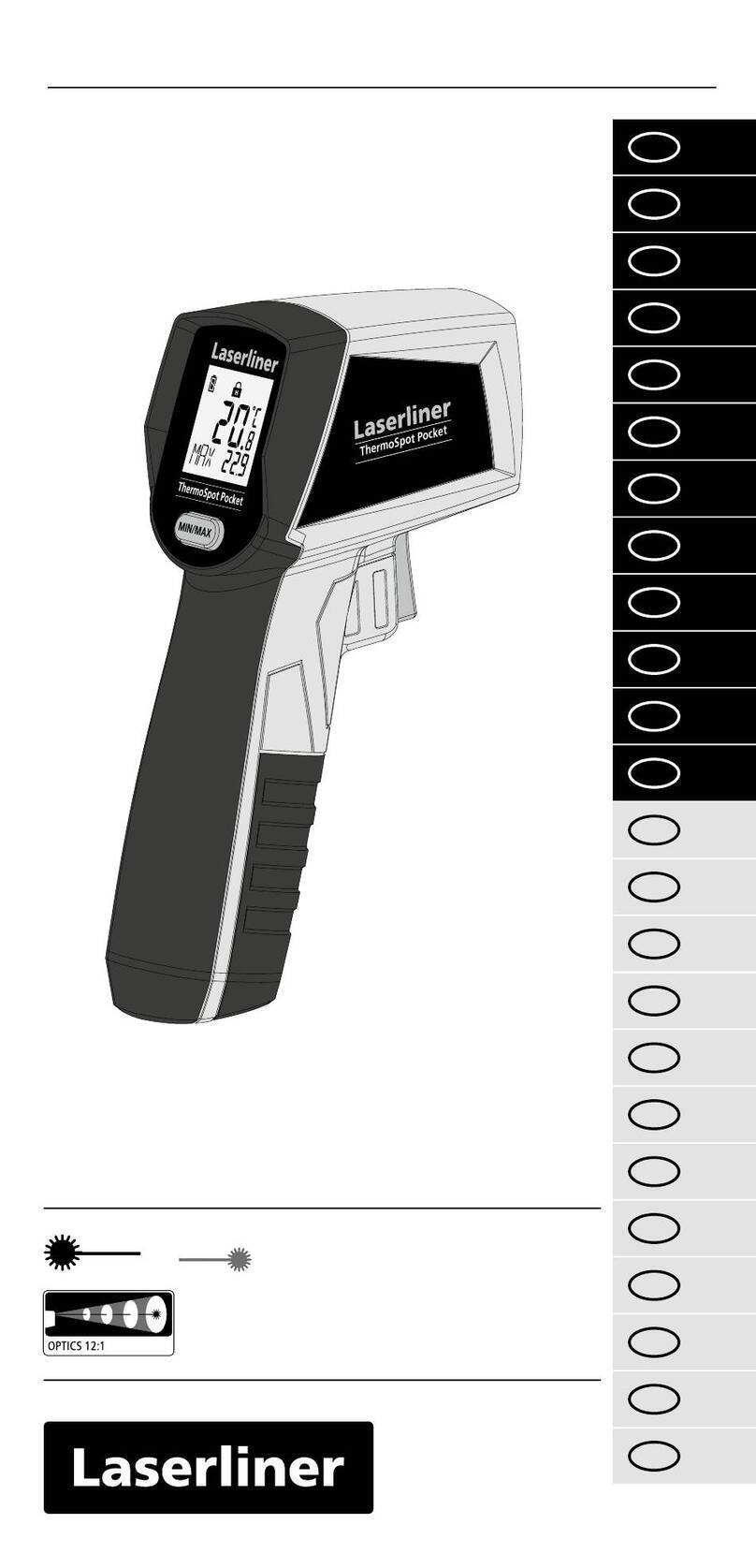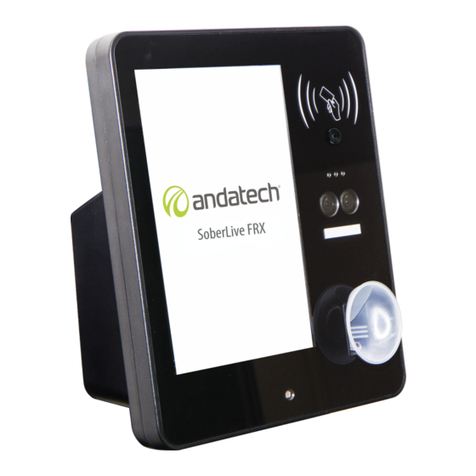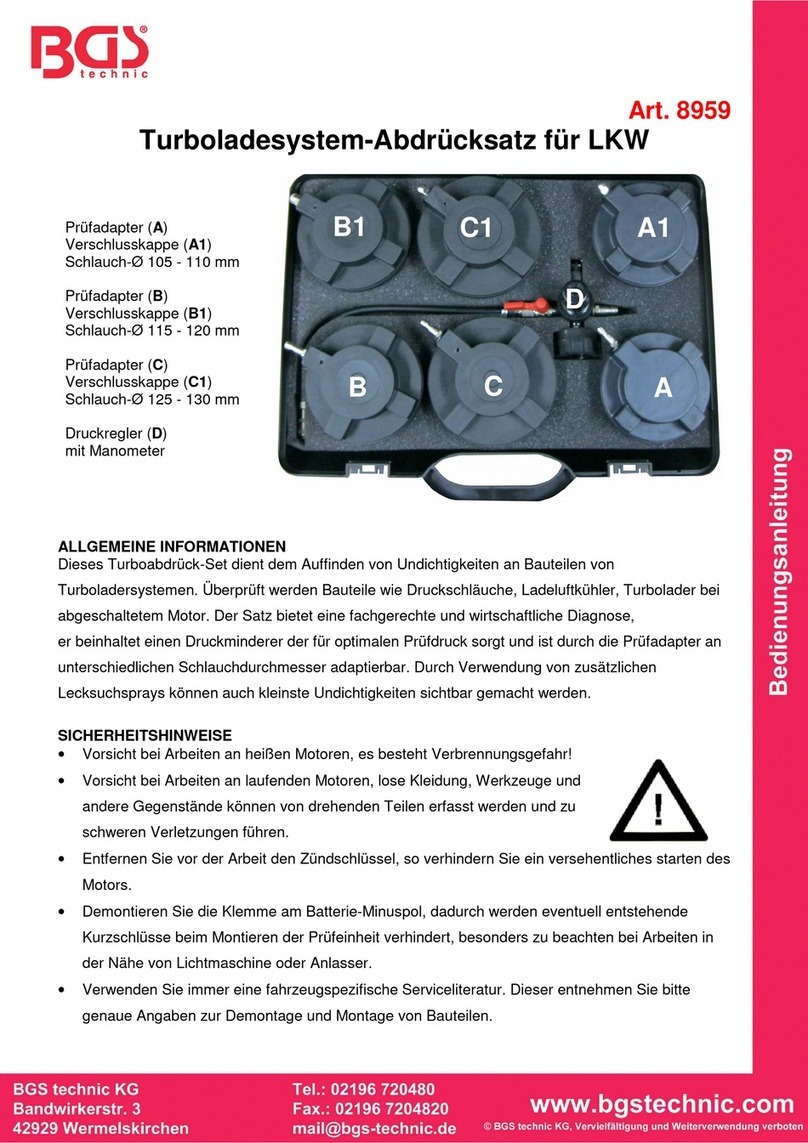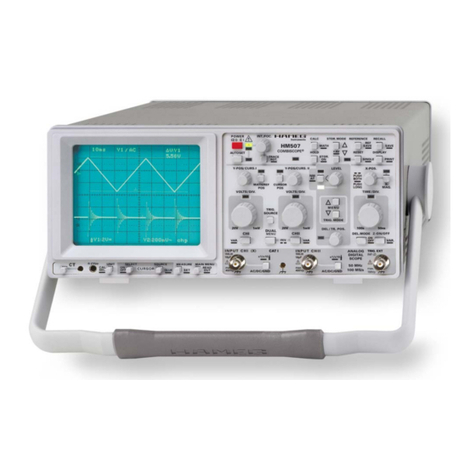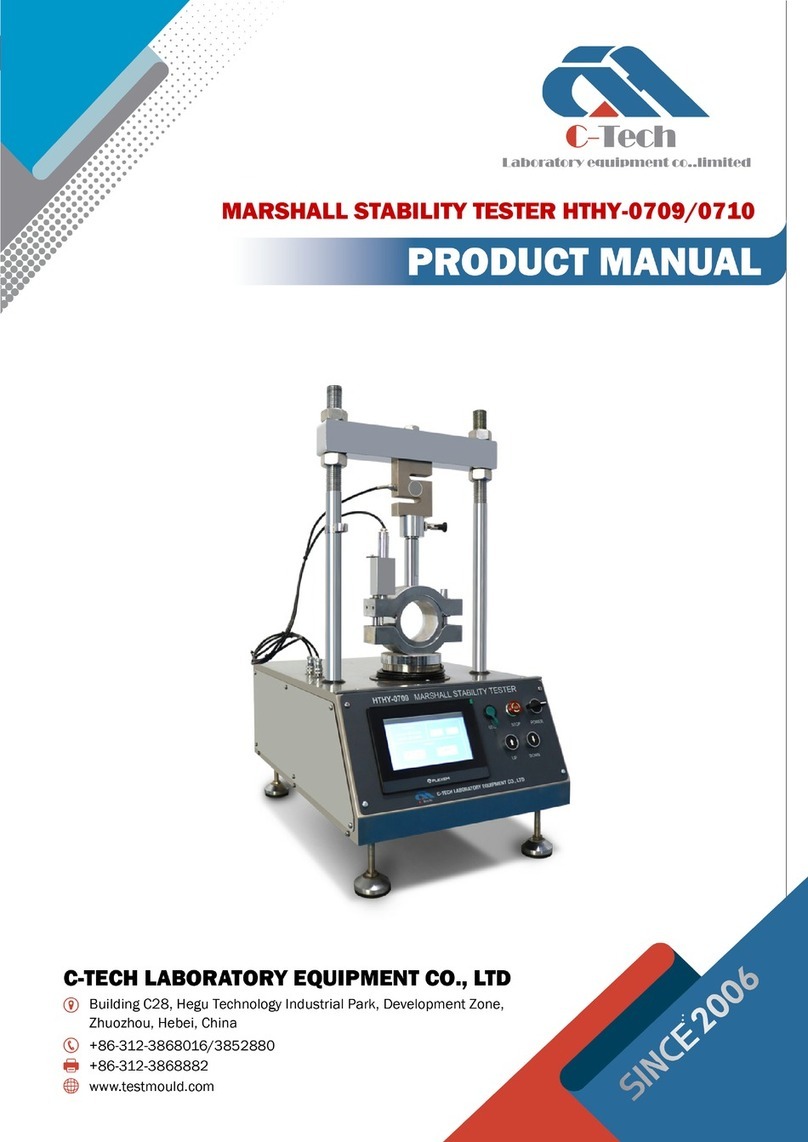Sanwa PM3 User manual

PM3
DIGITAL MULTITESTER
INSTRUCTION MANUAL

【1】SAFETY PRECAUTIONS
: Before use, read the following safety precautions
This instruction manual explains how to use your multimeter PM3
safely. Before use, please read this manual thoroughly. After
reading it, keep it together with the product for reference to it
when necessary.
The instruction given under the heading WARNING
CAUTIONmust be followed to prevent accidental burn or
electrical shock.
1-1 Explanation of Warning Symbols
The meaning of the symbols used in this manual and attached to
the product is as follows.
:Very important instruction for safe use.
・The warning messages are intended to prevent accidents to
operating personnel such as burn and electrical shock.
・The caution messages are intended to prevent damage to the
instrument.
DCV :DC voltage ACV〜: AC voltage Ω:Resistance
:Buzzer :Diode :Capacitance
Hz:Frequency DUTY:Duty cycle :Ground
+:Plus −:Minus :Double insulation
1-2 Warning Instruction for safe use
WARNING
To ensure that the meter is used safely, be sure to observe the
instruction when using the instrument.
1. Never use meter on the electric circuit that exceed 3.6kVA.
2. Pay special attention when measuring the voltage AC 30Vrms
(42.4 V peak) or DC 60V or more to avoid injury.
3. Never apply an input signal exceeding the maximum rating
input value.
4.
Never use meter for measuring the line connected with equipment
(i.e. motors) that generates induced or surge voltage since it may
exceed the maximum allowable voltage.
ー1ー

5.
Never use meter if the meter or test leads are damaged or broken.
6. Never use uncased meter.
7.
Always keep your fingers behind the finger guards on the probe
when making measurements.
8.
Be sure to disconnect the test pins from the circuit when changing
the function.
9. Never use meter with wet hands or in a damp environment.
10.
Never open tester case except when replacing batteries.Do not
attempt any alteration of original specifications.
11.
Do not use the device near an item of strong electromagnetic
generation or a charged item.
12.
To ensure safety and maintain accuracy, calibrate and check the
tester at least once a year.
13.The multimeter restricts in use in indoor.
1-3 Maximum Overload Protection Input
*:AC voltage is regulated by rms valus of sinusoidal wave.
【2】APPLICATION AND FEATURES
2-1 Application
This instrument is portable multimeter designated for measurement
of weak current circuit.
2-2 Features
・This multimeter is very thin type. Body thickness is 8.5mm.
・Sharp contrast LCD with character 13.6mm high is employed,
and unit symbols is displayed on the screen of the LCD.
・Addition function: Hz/Duty , Relative and Data Hold.
・Auto power off(15 min.) It is able to cancel it.
・The instrument has been designed in accordance with the
safety standard IEC 1010-1. (DC/AC 500V Max. CATII)
Function
DCV (Hz/ DUTY)
ACV (Hz/DUTY)
Ω///
Input
+,−
Maximum rating
Input value
DC500V
AC500V
Voltage and current
Input prohibited
Maximum overload
Protection voltage
DC500V, AC500V or
Peak Max.700V
ー2ー

【3】NAME OF COMPONENT UNITS
【4】DESCRIPTION OF FUNCTIONS
WARNING
In the case of action or cancel that function as follows, do not
turn the function switch in the condition applied input.
1) Power switch and function switch
Turn this switch to turn on and off the power and select the functions of
DCV, ACV,Ω,,,.
2) Select switch
This switch uses it for the switching of Ω///.Inthecaseofthe
mode change as
Ω→→→→Ω.
3) Data hold switch
When this switch is pressed, the data display at that time continues
(DH lights on the display). When the measuring input changes, the
display will not change. When this switch is pressed again, the hold
status is canceled you can return to the measuring status. (DH on the
display disappears.)
(DATA HOLD function does not work when measuring frequency.)
Case holder
Display
Select switch
Relative switch
Data hold switch
Hz/DUTY select
switch
Power switch and
function switch
Test pins
Finger
guards
Test probe
(Red and Black)
Test leads
ー3ー

4)Relative measurement switch (RELATIVE)
Suppose that actual value is X1 when REL switch is pressed. Then,
value of X-X1 is displayed for actual input value X after that. Each time
pressing REL switch, value of X1 is updated. This function is except
the Hz/DUTY measurement mode.
<In the case of use at the DCV and ACV function>
・In the case of canceled, please push the switch again.
・
The measurement range is fixed to the range in the point that pushed
the switch. About measurement after this, the range is fixed. To
return to the auto range, please stop measurement once and set the
function again.
・
Do not measure any signal that exceeds the maximum of current range.
<In the case of use Ω、、 function>
・WhenO.Lis displayed, setting and cancellation are not possible.
・In the case of canceled, please push the switch again.
・
The resistance measurement range is fixed to the range in the point
that pushed the switch. About measurement after this, the range is
fixed. To return to the auto range, please stop measurement once
and set the function again.
<In the case of use function>
・In the case of canceled, please push the switch again.
・
The Capacitance measurement is auto range mode only. After canceled
relative mode, it is possible measurement with the auto range.
5) Hz/DUTY (Frequency/Duty)switch
This switch uses it for the switching of Hz/DUTY. In the case of the
mode change as Hz→DUTY→voltage measuring mode→Hz.
●When it returns it to the voltage function after the Hz/DUTY
measurement the range is fixed automatically. (DCV function is
400mV. ACV function is 4V.) Please stop measurement once to
cancel the manual range. And please do measurement after the
function is set up again.
6) Auto power off
This equipment incorporates an auto power off which turns off the
display in about 15 minutes to save power. If you want to continue to
use the equipment, press the SELECT switch. To cancel auto power
off for long time measurement, turn function switch from OFF position
to position of desired function while holding down SELECT switch.
Then release SELECT switch approx. 2sec. to 3sec. after.
ー4ー

【5】MEASUREMENT PROCEDURE
5-1 Start-up Inspection
WARNING
1.
Be sure to pre-check the meter
before use.
2.Do not use a damaged meter
and test leads.
3.
Check continuity of test leads.
4.
When a battery exhaust mark
appears in the display, replace
the battery with a new one.
*note:Non-marking may suggest that a battery be exhausted.
YES
YES
YES
NO
NO
Main unit
and test leads
damaged?
Is a battery
Exhaustion mark is
on?(*note)
Display shows
000.0〜1.0?
Short the RED and
BLACK test pin
Set the function
switch toΩ.
Replace the battery.
Please check again
Stop using it and have
it repaired.
To avoid danger of shock hazard,
do not use multimeter with
damage and repair the meter.
End of pre-check
START
NO
ー5ー

5-2 Voltage, Hz/DUTY measurement
WARNING
1.
Never apply an input signal exceeding the maximum rating input value.
2.
Be sure to disconnect the test pins from the circuit when changing
the function.
3.
Always keep your fingers behind the finger guards on the probe
when making measurements.
5-2-1 Voltage Measurement (DCV,ACV)
Maximum rating input value DC/AC 500V
1) Applications
DCV : Measures batteries and DC circuits.
ACV 〜: Measures sine-wave AC voltage as lighting voltages.
2) Measurement procedure
①Set the function switch
DCVorACVfunction.
②Apply the black test pin
to the negative potential
side of the circuit to measure
and the red test pin to the
positive potential side.
③Read the value on the display.
④
After measurement, remove
the red and black test pins from
the circuit measured.
●The display fluctuates when
the test leads are removed. This is not malfunction.
●
Since this instrument employs the means value system for its AC
voltage measurement circuit, AC waveform other than sine wave
may cause error.
●
In the AC4V ranges a figure of about 3〜9 conuts will stay on even if
no input signal is present.
●The accuracy guaranteed frequency range is 40Hz to 400Hz.
<DCV>
<ACV>
ー6ー

5-2-2 Hz/DUTY Measurements
Maximum rating input value 60.00kHz / 99%
CAUTION
The setting and measurement (At the time of AC voltage input) of the
Hz/DUTY are possible at the DCV function too. However, we recommend
the use in the ACV function.
1) Applications: Measures frequency and duty of any circuit.
2) Measurement procedure
①Set the function switch
at ACV function. Push the
Hz/DUTY switch one time,
and select the Hz function.
(The unit display is Hz display.)
In the case of duty measurement,
then push the Hz/DUTY switch
one more time, and select
the duty function.
(The unit display is % display.)
②Apply the red and black test pins to the circuit to measure.
③Read the value on the display.
④After measurement, remove the red and black test pins from
the circuit measured.
●With measuring terminals disconnected, display may overflow
or value may unsteadily fluctuate. There are not malfunctions.
●Input sensitivity varies according to frequency and wave-form.
●Please refer to 8-2 Measurement Range and Accuracy.
●It is only auto range mode.
●When it returns it to the voltage function after the Hz/DUTY
measurement the range is fixed automatically. (DCV function is
400mV. ACV function is 4V.) Please stop measurement once to
cancel the manual range. And please do measurement after
the function is set up again.
●DATA HOLD function does not work when measuring frequency.
●The meter cannot measure frequency that does not go to and fro
O voltage.
ー7ー

5-3 Resistance Measurement (Ω)
WARNING
Never apply voltage to the input terminal.
1)
Application: Resistance of resistors and circuits are measured.
2) Measuring ranges:400Ω〜40MΩ(6 range)
3) Measurement procedure
①Set the function switch at
Ω/ / / function.
②Apply the black red test
pin to measured circuit.
③Read the value on the
display.
④After measurement, remove
the red and black test pins
from the circuit measured.
●If measurement is likely to be influenced by noise, shield the
object to measure with negative potential (test lead black).
●The input terminals release voltage is about 0.4V.
5-4 Testing Diode ()
WARNING
Never apply voltage to the input terminal.
1) Application: The quality of diodes is tested.
2) Measurement procedure
①Set the function switch
at Ω/ / / function
and select the function
by SELECT switch.
②Apply the black test pin to
the cathode of the diode and
the red test pin to the anode.
③Make sure that the display
shows a diode forward voltage drop.
Resistor
Diode
ー8ー

Table tap
Plug
④Replace the red and black test pins, make sure that the
displays the same as that when the test leads are released.
⑤After measurement, release the red and black test pins from
the object measured.
Judgment: When the items ③and ④are normal, the diode is good.
●The input terminals release voltage is about 1.5V.
5-5 Checking Continuity ( )
WARNING
Never apply voltage to the input terminal.
1)
Application: Checking the continuity of wiring and selecting wires.
2) Measurement procedure
①Set the function switch
at Ω///function
and select the function
by SELECT switch.
②Apply the red and black
test pins to a circuit or
conductor to measure.
③The continuity can be
judged by whether the
buzzer sounds or not.
④After measurement, release the red and black test pins from
the object measured.
●The buzzer sounds when the resistance in a circuit to measure
is less than about 10Ω〜100Ω.
●The input terminals release voltage is about 0.4V.
5-6 Capacity Measurement ( )
WARNING
1. Never apply voltage to the input terminal.
2. This is not suitable for measurement of electrolytic condenser
such as a large leakage condenser.
1) Application: Measures capacitance of capacity.
ー9ー

2) Measurement procedure
①Set the function switch
at Ω///nF function
and select the function
by SELECT switch.
②Press the RELATIVE
switch to make display
show 00.00nF. (TheREL
mark illuminates in the upper
right area of the display.)
③Apply the black red test pin
to capacitor.
④Read the value on the display.
⑤After measurement, remove the red and black test pins from
the circuit measured.
●For measurement of 100nF or below, the display will not stabilize
due to the influence of ambient noise and floating capacity.
●Necessarily please discharge the electric charge that was
charged to the condenser before measurement.
●As the capacitance increases, the measuring time becomes
longer. (Example: approx. 5sec. at 10µ. Approx.45sec. at 150µ
F.)
【6】MAINTENANCE
WARNING
1.
This section is very important for safety. Read and understand the following
instruction fully and maintain your instrument properly.
2.
The instrument must be calibrated and inspected at least once a year to
maintain the safety and accuracy.
6-1 Maintenance and inspection
1. Appearance:Is the appearance not damaged by falling?
2. Test leads: Is the cord of the test leads not damaged?
Is the core wire not exposed at any place of the test leads?
If your instrument falls in any of the above items, do not use it and
have it repaired or replace it with a new one.
Capacitor
ー10ー

●Make sure that the test leads are not cut, referring to the section.
6-2 Calibration
The dealer may conduct the calibration and inspection. For more
information, please contact the dealer.
6-3 How to Replace Battery
WARNING
1.
If the rear case is removed with input applied to the input terminals,
you may get electrical shock. Before starting the work, always
make sure that no inputs is applied.
2.
Be sure to use the fuse is same rating so as to ensure safety and
performance of tester.
3.
When operators remove the rear case, do not touch the internal
parts or wire with hand.
<How to replace the battery>
①Remove the rear case
screw with a screwdriver.
②Remove the rear case.
③Take out the battery and replace it with a
new one.
④Attach the rear case and fix it with the screw.
CAUTION
Set a battery with its polarities
facing in the correct directions.
6-4 Storage
CAUTION
1.
The panel and the case are not resistant to volatile solvent and
must not be cleaned with thinner or alcohol. For cleaning, use
dry, soft cloth and wipe it lightly.
2.
The panel and the case are not resistant to heat. Do not place
the instrument near heat-generating devices (such as a soldering iron)
3.
Do not store the instrument in a place where it may be subjected
to vibration or from where it may fall.
4.
For storing the instrument, avoid hot, cold or humid places or places.
Under direct sunlight or where condensation is anticipated.
Following the above instructions, store the instrument in good environment.
Coin type
lithium battery
CR2032
Screw
ー11ー

【7】AFTER-SALE SERVICE
7-1 Warranty and Provision
Sanwa offers comprehensive warranty services to its end-users
and to its product resellers. Under Sanwa's general warranty policy,
each instrument is warranted to be free from defects in
workmanship or material under normal use for the period of one (1)
year from the date of purchase.
This warranty policy is valid within the country of purchase only,
and applied only to the product purchased from Sanwa authorized
agent or distributor.
Sanwa reserves the right to inspect all warranty claims to determine
the extent to which the warranty policy shall apply. This warranty
shall not apply to fuses, disposables batteries, or any product or
parts, which have been subject to one of the following causes:
1. A failure due to improper handling or use that deviates from
the instruction manual.
2. A failure due to inadequate repair or modification by people
other than Sanwa service personnel.
3. A failure due to causes not attributable to this product such as
fire, flood and other natural disaster.
4. Non-operation due to a discharged battery.
5. A failure or damage due to transportation, relocation or
dropping after the purchase.
7-2 Repair
Customers are asked to provide the following information when
requesting services:
1. Customer name, address, and contact information
2. Description of problem
3. Description of product configuration
4. Model Number
5. Product Serial Number
6. Proof of Date-of-Purchase
7. Where you purchased the product
Please contact Sanwa authorized agent / distributor / service
provider, listed in our website, in your country with above
information. An instrument sent to Sanwa / agent / distributor
without those information will be returned to the customer.
Note:
1) Prior to requesting repair, please check the following:
Capacity of the built-in battery, polarity of installation and
discontinuity of the test leads.
ー12ー

2) Repair during the warranty period:
The failed meter will be repaired in accordance with the
conditions stipulated in 7-1 Warranty and Provision.
3) Repair after the warranty period has expired:
In some cases, repair and transportation cost may become
higher than the price of the product. Please contact Sanwa
authorized agent / service provider in advance.
The minimum retention period of service functional parts is 6
years after the discontinuation of manufacture. This retention
period is the repair warranty period. Please note, however, if
such functional parts become unavailable for reasons of
discontinuation of manufacture, etc., the retention period may
become shorter accordingly.
4) Precautions when sending the product to be repaired:
To ensure the safety of the product during transportation,
place the product in a box that is larger than the product 5
times or more in volume and fill cushion materials fully and
then clearly mark “Repair Product Enclosed” on the box
surface. The cost of sending and returning the product shall be
borne by the customer.
7-3 SANWA Website
http://www.sanwa-meter.co.jp
E-mail: [email protected]
【8】SPECIFICATIONS
8-1 General Specifications
Measuring Method: ΔΣ
Display: 4000 counts max.
Range selection: Auto ranges
Over display:O.Ldisplay
Polarity: Automatic selection (only−is displayed)
Low Battery Indication:
Sampling rate: Approx. 3 times/sec.
Accuracy assurance temperature /humidity range:
23±5℃80%RH max. No condensation.
Operating temperature/humidity range:
0〜40℃80%RH max. No condensation.
Storage temperature/humidity range:
-10〜50℃70%RH max. No condensation.
Environmental condition: Operating altitude <2000m, Pollution degree II
Power supply: Coin type lithium battery CR2032 (3V), 1 pcs.
Power consumption: Approx.6mW TYP. (at DCV)
Battery life: Approx.150 hours at DCV
Dimension and weight:108(H)×56(W)×11.5(D)mm Approx.50g
Accessories: Instruction manual 1, Case holder 1
−+
ー13ー

Safety: IEC 1010-1(EN61010-1)
≦DC・AC 500V: Designed to protection ClassII
requirement of IEC 1010-1, Pollution degree II.
EMC: EN50081-1 (EN55022), EN50082-1 (EN61000-4-2)
EN50082-1 (EN61000-4-3), EN50082-1 (ENV50204)
Installation Category(Overvoltage Category) II
:Local Level
Appliance
Portable Equipment
8-2 Measurement Range and Accuracy
Accuracy assurance range:23±5℃80%RH MAX. No condensation.
Function
DCV
ACV
〜
Ω
CAP.
Range
400.0mV
4.000V
40.00V
400.0V
500V
4.000V
40.00V
400.0V
500V
400.0Ω
4.000kΩ
40.00kΩ
400.0kΩ
4.000MΩ
40.00MΩ
4.000nF
40.00nF
400.0nF
4.000μF
40.00μF
200.0μF
Accuracy
±(0.7%rdg+3dgt)
±(1.3%rdg+3dgt)
±
(2.3%rdg+10dgt)
±(2.3%rdg+5dgt)
±(2.0%rdg+5dgt)
±(5.0%rdg+5dgt)
±(10%rdg+5dgt)
-------------------------------------
±
(5.0%rdg+10dgt)
±
(10%rdg+15dgt)
Input
Resistance
≧100MΩ
Approx.11MΩ
Approx.10MΩ
Approx.11MΩ
Approx.10MΩ
Remarks
*Accuracy in the
case of sine wave.
*Frequency range:
40〜400Hz
*Open voltage: Approx. 0.4V
*The measuring current changes
according to the resistance
measure.
*Accuracy was measured
after canceling display value
by relative key.
ー14ー

Accuracy in the case of sine wave.
◎Accuracy calculation
For example:Measurement DCmV
Displayed value:100.0mV
Accuracy :400mV range ・・・・±(0.7%rdg+3dgt)
Error :±(100[mV]×0.7%+3[dgt] )=±1.0[mV]
True value :100.0[mV]±1.0[mV](In a range of 99.0〜101.0mV)
*3[dgt] in the 400mV range corresponds to 0.3mV.
Specifications and external appearance of the product
described above may be revised for modification without
prior notice.
・Buzzer sounds at less than 10〜120Ω
・Open voltage: Approx. 0.4V
Open voltage: Approx 1.5V
Function
Hz
DUTY
BUZZER
DIODE
Range
9.999Hz
99.99Hz
999.9Hz
9.999kHz
60.00kHz
0.1〜99%
Accuracy
±(0.7%rdg+5dgt)
-------------------------------------
Remarks
*Accuracy in the case of sine
wave.
9.999Hz〜9.999kHz: 10Vrms〜250Vrms.
60.00kHz: 40Vrms
〜
100Vrms.
About input sensitivity and
frequency characteristic:
(Square wave DUTY 50% input)
2.5V 0 to peak input:≧1kHz
6V 0 to peak input:≧10kHz
40V 0 to peak input:≧60kHz
ー15ー
Table of contents
Other Sanwa Test Equipment manuals
Popular Test Equipment manuals by other brands
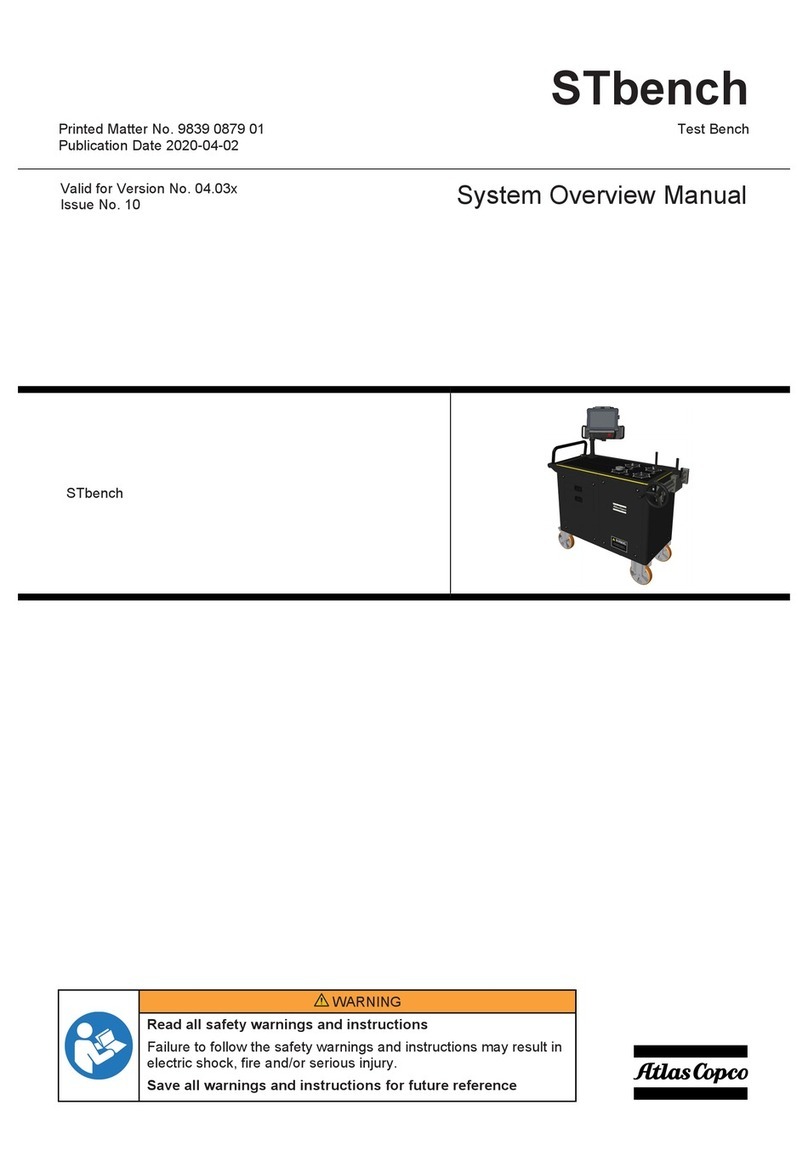
Atlas Copco
Atlas Copco STbench System Overview Manual
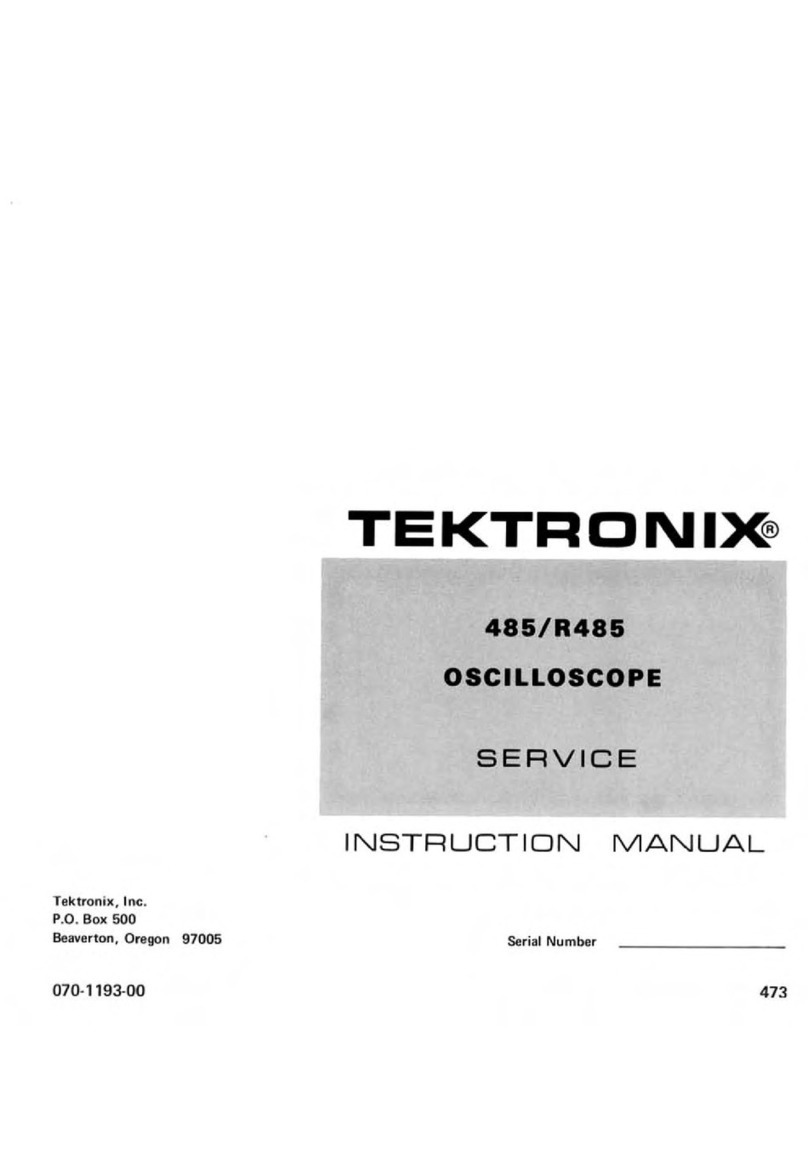
Tektronix
Tektronix 485 instruction manual

PIE
PIE PIECAL 422 Product description
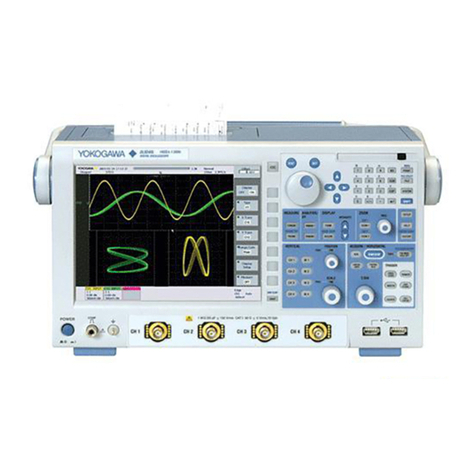
YOKOGAWA
YOKOGAWA DL9000 Series user manual
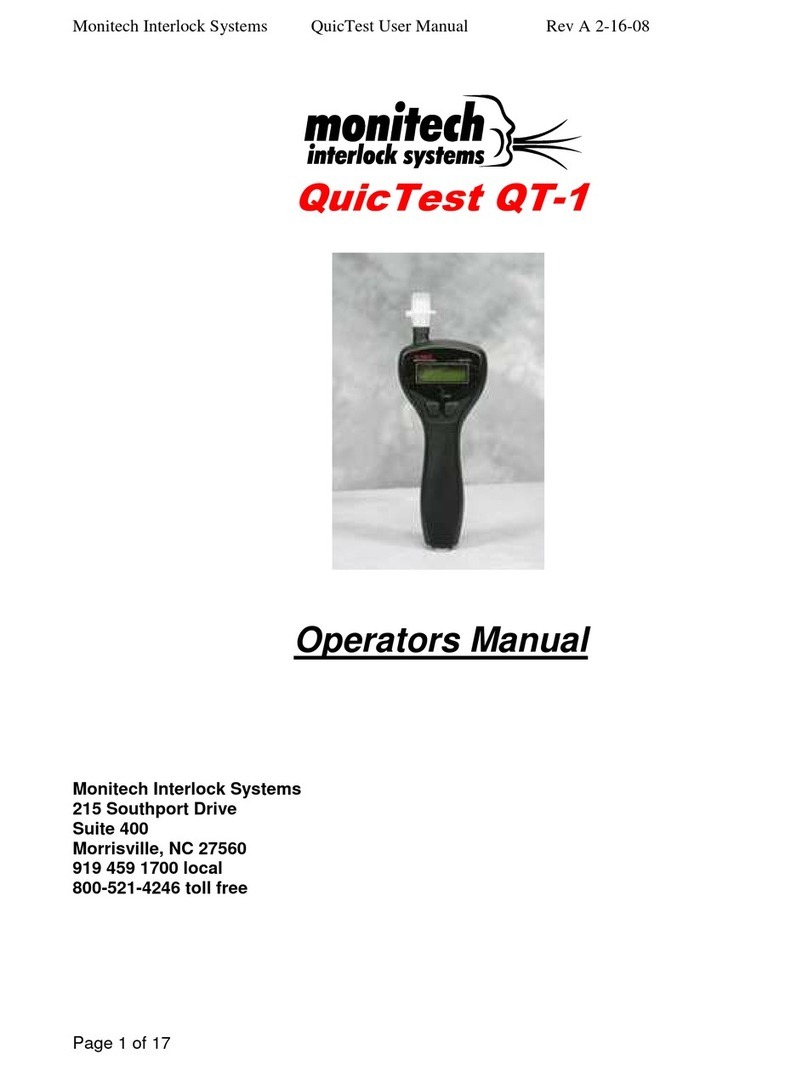
Monitech Interlock Systems
Monitech Interlock Systems QuicTest QT-1 Operator's manual

Analog Devices
Analog Devices Hittite HMC-T2000 user manual
